how to draw a contour map calculus

Which trail would you lot take?
Imagine. You're out mountain climbing with your friends.
You pull out your map and see two hiking trails.
The first route has closely-spaced profile lines.
Simply the 2nd route has widely-spaced spaced profile lines.
Which hiking trail would You lot take?
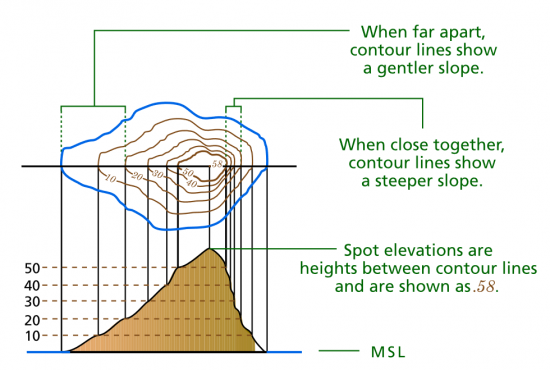
For the slow-and-steady climber, you'd option the 2d route considering widely-spaced contour lines mean the slope is gradual. But if you lot picked the commencement route, you're the blazon of free climber who scales mountains with just a pickaxe. This is because when contours are close together, information technology means that the slope is steeper.
For a quick definition, a contour line joins points of equal and constant values. For example, contours on an meridian have constant heights that are the same on each line in a topographic map.
Are these contour lines mountains or depressions?
When you take a closed contour like the one below, this means there is a hill/mountain or depression.
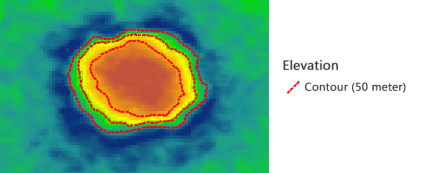
You don't actually know unless in that location is a label on the profile line. In the example below, nosotros've added labels and it should be articulate that information technology's a depression.

And this isn't just whatsoever depression. This is the massive meteor crater that struck Arizona a long time agone.
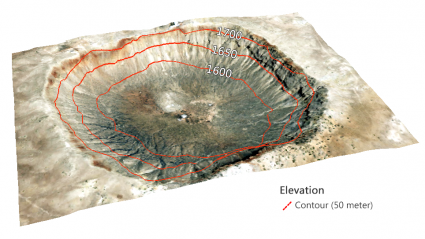
On some maps, cartographers use teeth marks or hachures for depressions at craters or volcanoes because it marks the meridian goes up or down.
READ More than: A Topographic Profile of Arizona's Massive Meteor Crater
How does Mount Fuji'south contour lines look similar?
In this case, closed contour lines indicate a mountain. The beautiful Mount Fuji stands 3,776 meters tall above ocean level. At 250-meter spacing, hither's how the profile lines await:
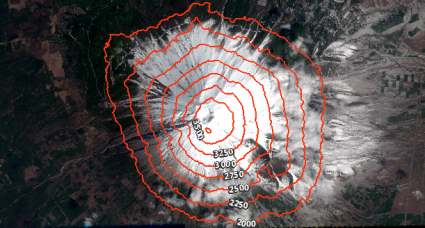
When you run across Mount Fuji in 3D, you can run across that information technology's quite steep as the contours are relatively closely spaced together.

So far, we've seen examples of two types of airtight contours, but how practice contours look like in valleys?
The rule of V and U-shaped valleys
Valleys are elongated low-lying depressions normally with a river flowing through it. You know that you're looking at a valley lesser when contour lines are V or U-shaped.
Here is an instance of a 3D view of the picturesque Collayomi Valley in California:
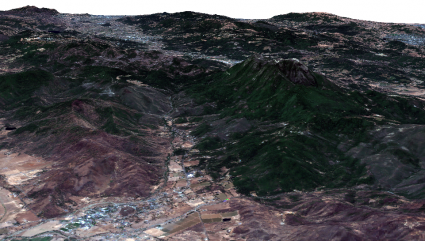
All rivers flow downhill from higher to the lower elevations, perpendicular to the contour line above it. As a dominion of thumb, the V-shaped profile is pointing upstream (the opposite direction from the menstruation of a stream or river).
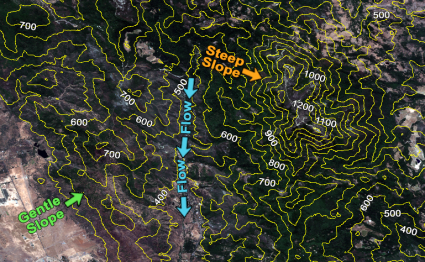
The "V" shape contours indicate streams and drainage. Every bit you can see, the "V" points uphill to a higher pinnacle. Mostly, you can connect the apexes of the upwardly-pointing, "V" shaped contour lines to delineate a stream. Farther to this, you can approximate a stream gradient by counting the number of contours that cantankerous a stream with the contour interval.

The slope is always perpendicular to contour lines. The less separation between profile lines means a steeper slope and vice versa. When there are evenly spaced contours, the slope is compatible.
At a stream junction, profile lines form a "M" or "W" shape. This tin can be interpreted as two "V-shaped contours intersecting.
What about ridges and gullies?
Over time, gullies class through erosion of running water on hillsides. A consequence of ii eroded gullies is a spur at the center on the face of a hillside that sticks out. Both gullies and spurs run from ridgelines to valley bottoms.

Gullies (or draws) are characterized by "U" or "5" shaped profile lines with their closed-end pointing towards college acme. On the other mitt, spur profile lines signal toward lower pinnacle.
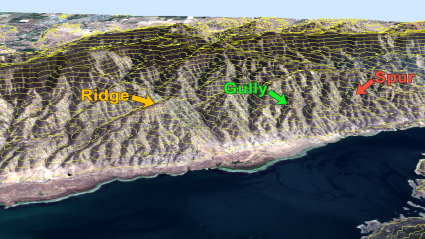
In 2d, these valley landscape features are a bit more difficult to run across. Only it's key to remember how ridges point downslope and gullies point upslope.
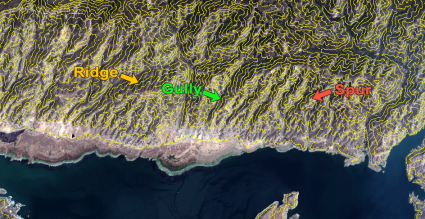
Why do contour lines never cross?
It'due south unlikely that contours cross, merely sometimes they do. When the terrain is an overhang or cliff, contour lines will cross or touch.
The cliffs in Látrabjarg, Iceland are up to 440 meters tall. When y'all generate 100-meter contours, they are very close to converging.
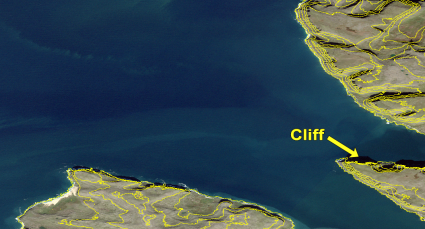
In 3D, y'all can run into how steep these cliffs are. And then if these contours did cantankerous, it's very likely an overhang. Or it could exist an error in the plan.
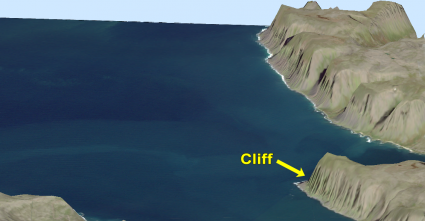
If you use your imagination, movie an overhang where the terrain hangs outward. This would be a rare exception when two contours that cantankerous.
How to depict profile lines manually?
Yous can easily generate contour lines with the click of a button in CAD or GIS software. But what if you want to draw it by manus?
First, you lot accept to choose a contour interval. For case, we're going to use a contour interval of x meters. So this means that there will be a contour every ten meters.
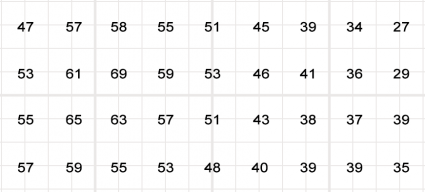
Betwixt transition points of ten (30, 40, fifty, etc), add markers where to draw lines. Basically, depict or interpolate between the lines.
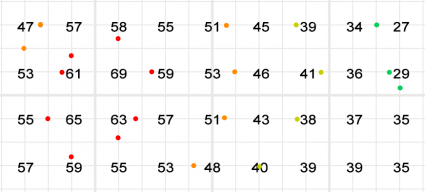
Now that nosotros have points to connect, permit's draw smooth contour lines for each interval. Essentially, we are connecting the points with lines.

And there we have it.
What do nosotros apply contour lines for?
In our example, contour lines represented constant elevation and showed the topography of the landscape.
Just meteorology (isopleth), magnetism (isogon) and even drive-time (isochrones) as well use contours for different purposes.
The closeness of contours indicates slope. Irregular contours mean rugged terrain. It's rare in nature for contours to cross. But they tin for overhangs and cliffs.
What are some other types of contours you've seen in nature?
References
Topographic Maps: The Basics, Natural Resources Canada, 2022. Reproduced with the permission of the Department of Natural Resource, 2022.
Subscribe to our newsletter:
Source: https://gisgeography.com/contour-lines-topographic-map/
Posted by: lujanthicents.blogspot.com


0 Response to "how to draw a contour map calculus"
Post a Comment